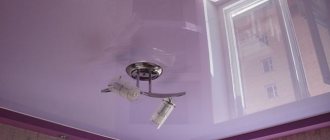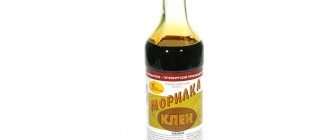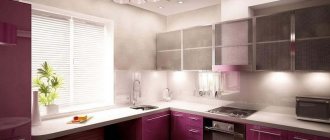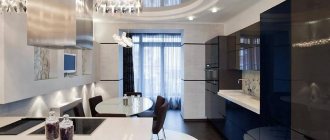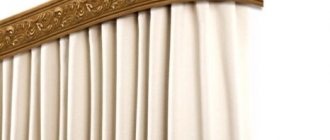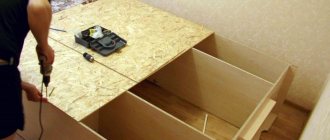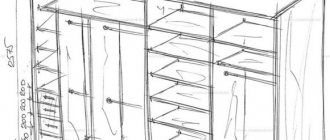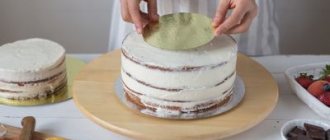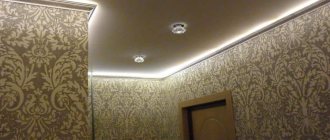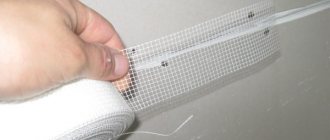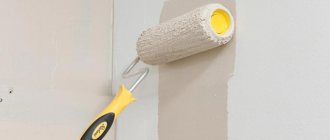Stretch ceilings are very popular today. And this is not at all surprising, because they can radically transform any room and have many advantages. But after installing the base covering, there is often an unsightly gap left between the new ceiling and the adjacent walls. To disguise it, a special tape for stretch ceiling is used. In addition to the fact that the plug will close the gap, it will also perform a decorative function, giving the room a finished and harmonious look.
Reasons for the formation of a gap near the wall
Upon completion of the installation work, the question immediately arises about the correctness of the measurements taken and the installation technology, if as a result of the work a gap has formed between the ceiling and the walls. In fact, the reason for its appearance is that the canvas is not attached directly to the walls, but on a special connecting profile that has certain parameters of thickness and width. Therefore, it will not be possible to install it close to the wall. In addition, the profile strips have a cavity into which the tension covering edging is inserted during installation.
This is why a gap forms at the wall. However, it can be hidden using a special masking tape for stretch ceilings. The need to use such an element is also due to the aesthetic side. After all, with a decorative plug the room becomes much more attractive.
To install the ceilings yourself or entrust it to professionals is, of course, your business. Only specialists have much more knowledge and experience in this field. You will also be able to demand a refund for the work or redo it if an error occurred and you were unhappy with the result.
Bottom line
Modern ceiling technologies do not stand still, and ceiling fastening systems have long appeared that do not require decorative plugs. This is a shadow profile, and the Stock system, and Lumpher came up with something of his own. But all these new technologies are noticeably more expensive, and therefore the classic elastic band will be in demand for a very long time.
Use only good tape that is easy to install, do not save these 1-2 rubles per meter. Use special tools for installation: various inserters, rollers, corner scissors for PVC. Measure the room using a laser tape measure.
Share with friends:
Purpose and advantages of decorative plugs
Masking tape for suspended ceilings used as a finishing element in appearance resembles a thin profile that bends easily, is soft to the touch, but does not break. It is made from PVC, like film sheets. With the help of such a universal accessory, you can bypass even the most complex curved structures.
The tape has the following advantages:
- reliably masks the gaps left after installing a suspended ceiling;
- used when two canvases are spliced together if the room is large in area;
- serves as a decorative element for finishing and decorating multi-tiered ceiling systems;
- the variety of colors makes it possible to choose the best option for any texture and tone of the coating;
- the tape can be dismantled and reused after this;
- the material used in the manufacture of camouflage plugs is resistant to chemical compounds;
- products have a long service life without losing their original appearance;
- ease of fastening does not require specific knowledge and skills. The tape is simply inserted into a special profile;
- Available in different lengths, which allows minimizing joints between individual elements;
- does not take up additional space from the premises compared to ceiling plinths. This is true for compact rooms;
- It's inexpensive.
As for the minuses, there are only two of them. And both of them relate to interior design:
- using tape will not hide too obvious defects in the walls;
- The plug does not allow the installation of hidden lighting. If you are faced with such a task, you will have to use baseboards or curtain rods designed for this purpose.
Definition
There is no doubt that suspended ceilings are by far the most popular type of ceiling decoration. A variety of types and reasonable prices are considered the main factors in favor of this type of finishing. But you also need to know about the disadvantages of a stretch ceiling.
- Gaps between the wall and the ceiling surface.
- Noticeable grooves in the tension fabric design.
- Joint holes on the ceiling surface material.
To eliminate these difficulties, designers resort to a variety of inserts. Which not only perfectly mask noticeable holes, but also decorate the overall decor of the ceiling.
Types of plugs
In addition to the plugs under consideration, two more elements are used for finishing tension coverings: decorative cord and ceiling plinth. They are also available in a variety of colors and textures and act as decorative elements.
Read about suspended ceilings with texture.
Masking tape
Masking tapes for suspended ceilings are divided into three main types according to their shape:
- T-plug. The main material used in its manufacture is rigid PVC. This texture makes it possible to decorate only smooth wall surfaces with it, for example, tiles, porcelain stoneware;
- L-shaped or L-shaped. For its production, PVC of a softer and more elastic texture is used, so with the help of such a decorative element, cracks in wall surfaces with significant unevenness can be masked. Very often, this type of tape is used to design transitions from one tier to another in curved plasterboard structures.
The versatility of the element allows it to be installed very quickly. However, there is a small feature that experienced specialists warn about. The special geometric shape prevents reliable fixation of the tape to the wall if a plastic baguette is used under a suspended ceiling. Therefore, over time, the product begins to sag, and the walls look uneven. Another thing is an aluminum profile that does not bend. When used as the basis of a suspended structure, the tape will not lose its original shape;
- F-shaped. It serves as a kind of connector between several canvases when the installation of a stretch ceiling is carried out in large areas. Moreover, it can be safely used for both aluminum and plastic baguettes.
On a note! When purchasing masking tape, consider the information provided by the manufacturer. High-quality products do not have a strong rubber smell, and perform the tasks assigned to them perfectly.
Decorative cord
One of the types of decorative tape for suspended ceilings is a special cord. It is also installed upon completion of installation work. The cord can be made in different weaves and from different materials. It can be a regular rope or with added metal threads. The thickness of the models varies and is 8, 10 or 12 mm. Today, this decor option is more widespread than classic ribbons.
The main advantage of a decorative cord is practicality. Any dirt can be removed from the product using regular washing. The cord is simply removed from the ceiling and just as easily installed back.
Ceiling plinth
Its fastening is carried out as close as possible to the suspended ceiling, so careless handling can damage the coating. Other disadvantages include:
- impossibility of reuse. For example, if it is necessary to dismantle the film covering during flooding, the film can be returned to its place, but the baseboard will have to be purchased new;
- Installing a plinth is more difficult than installing tape or cord. It makes it very difficult to get around corners in a room;
- high temperatures can cause cracking of the baseboard;
- lack of flexibility allows the products to be used only on flat surfaces;
- ceiling plinth costs more than masking tape.
But the plinth has one important advantage - you can install LED lighting under it. Using this technique, floating stretch ceilings are created.
Advice from professionals
The cost of a meter of masking tape averages from 20 to 30 rubles. This is not so much that instead of simply replacing it, try to paint or seal the insert with adhesive PVC film. This kind of homemade product turns out to be very clearly visible against the background of the ceiling decoration, so nothing good will come of such experiments.
If you had to repaint the vinyl covering, then during the work you can seal the surface with masking tape; there is no harm in painting along with the canvas. It is better to have the ceiling decor done professionally and install an updated cap.
Masking tape installation technology
If we talk about installing a plug, then there is no specific technique in this case. With each type of tape used, it is carefully pressed into a special groove. Such places for fixing decorative elements are called slot connectors. Installing the tape will save you not only from the technical gap, but also from the accumulation of dirt and dust between the wall and the tension covering.
The plug for suspended ceilings is mounted around the perimeter of the room. However, experts do not recommend using glue. For an even seam, craftsmen advise maintaining an angle of 90°.
The plug is installed using a conventional spatula. Before you begin attaching masking tape, check the evenness of the walls and structure. If possible, correct all defects.
Installation is carried out as follows:
- determine and cut the required length of the element by measuring the length of the wall surface;
- apply it to the gap formed;
- Using a spatula, carefully tuck the plug between the wall and the profile;
- Gently press the product and trim off any excess parts.
On a note! If you are installing an F-shaped tape, secure it using special wall corners or a PVC fastening profile.
When installing the tape, make sure that it does not stretch. When installing, it is better to compress the product lightly, since it will be exposed to different temperatures during operation. If the tape stretches, then over time the joints may separate (if two pieces of fabric are connected with it), and the plug will simply fall out in some areas.
Professionals advise fastening the product in small sections (3-5 m), joining individual parts at these intervals.
After the tape is installed, the ceiling will acquire a finished and harmonious appearance. An important advantage of a decorative plug is that it can be used repeatedly. To dismantle, just carefully pry off the tape with a screwdriver. After which she will effortlessly exit the profile.
Installing tape in the corners of the room
It is also very easy to install stretch ceiling edging in the corners. In this case, a spatula is also used. An alternative can be a rubber hammer.
The technology will be as follows:
- cut the product to the required length;
- connect two elements to each other. It is important that they form a strictly right angle of 90° between themselves. An exception is curved structures, when finishing which the angle formed with masking tape can be large;
- secure the tape with a spatula;
- Use a utility knife to cut off any excess parts.
Attaching corner masking tape
Installation of corner masking tape for suspended ceilings is carried out without the use of sharp objects to prevent damage to the canvas. For work you will need: a tape measure, a stepladder and a stationery knife.
On a note! All plugs are attached almost identically - at an angle of 90° into special grooves.
After purchasing the tape, without cutting off its individual pieces from the roll, insert one end into the opening resulting from the installation work. Carefully tuck it along the entire wall.
When you approach the first corner, use a utility knife to carefully cut the product so that its edge fits into the corner. Continue inserting the plug around the perimeter until the technical gaps are completely closed.
Such inserts are used not only for single-level ceilings, but also for multi-level structures when it is necessary to close the joints between adjacent panels. Stretch ceilings of all levels will undoubtedly transform any room.
Skirting boards for hidden lighting
Such designs are produced with an additional niche that provides for the placement of fluorescent lamps or LED strip. Illumination around the perimeter creates the effect of a “floating ceiling”. To improve the design, the gap is closed with foam or polyurethane foam skirting boards. The inside may have a foil coating to better reflect light rays.
Examples of using plinths with hidden lighting for a stretch ceiling.
If you notice an error, a non-working video or link, please select a piece of text and press Ctrl+Enter .
0
Selecting the color of the decorative plug
When decorating the interior, important attention must be paid to the colors that are planned to be included in the decoration. This applies not only to the shades of walls, floors and ceilings, but also to decorative elements. As for the decorative tape, designers advise choosing colors that will organically complement the basic tones used in the interior.
If you choose the color wisely, you can not only solve the design problem, but also eliminate a number of defects. In general, the shade of the decorative tape is selected according to three parameters:
- in the color of the ceiling. This technique is used in small rooms. By focusing on a decorative element, you will be able to visually expand the boundaries of space;
- in the color of the walls. This method, on the contrary, raises the ceilings and narrows the room;
- in the color of the ceiling and walls. The color of the tape should contrast with the main shades of the ceiling and wall surfaces.
An interesting solution can be achieved if you paint the tape the same shade as the furniture or large accessories.
On a note! Masking tapes for suspended ceilings can be painted in any tone with acrylic compounds. Only painting work is carried out before installing it to the ceiling.
A wide selection of colors allows you to choose the appropriate plug option for any type of decorative fabric.
The edging border for a stretch ceiling has differences not only in colors, but also in textures:
- glossy has good reflective ability, so designers often combine it with decorative lighting. Mainly used under glossy fabrics;
- matte tapes organically complement matte stretch ceilings;
- Patterned and embossed ribbons play a decorative role in the room.
SL insert
It is also produced in the form of masking tape, and due to its special shape, it can be used in rooms with uneven wall surfaces. The SL insert has a wide flange. The element is attached to a harpoon. This product is used to eliminate the gap between the canvases.
Features of SL insert:
- This type of plugs is larger in size and is installed using a different method.
- This element is ideal if the distance between the baguette and the wall is covered with finishing materials.
- Such products are made from rubber or plastic.
- They are produced in a variety of colors. The colored insert for suspended ceilings favorably emphasizes the design of the room, and light-colored plugs make the ceilings higher.
All types of camouflage elements for suspended ceilings fit well into the interior, they can be easily installed by hand, and a wide variety of colors allows you to purchase ideal finishing materials for any room.
These products provide the opportunity to carefully cover the space formed between the walls and ceiling, and, depending on the color scheme, emphasize the chosen style of the room or visually enlarge the space.
Finishing a stretch ceiling with a cord is the most modern and original option
Kant is a worthy alternative to previous solutions.
Today, edging ceilings with decorative cord wins on many counts and has several obvious advantages:
- A rope made of synthetic fabrics can repeat absolutely any shape. This design is also suitable for uneven walls. Because of its softness, it makes it possible to realize any idea in the design of ceilings.
- None of the decor options has such variety and scope for ideas. When choosing, you need to pay attention to two aspects: color and width of the rope. Regardless of the choice, decorative cords do not visually lower the ceilings or make the room narrower, but using different colors and widths you can also achieve different effects. For example, edgings in light colors or even with artificial lighting, on the contrary, will lift the room and give it an elevated atmosphere. And dark shades will make the room feel serious and conducive to mental activity. If you decide on a wide side, then the color should be contrasting with the walls, this will differentiate them and indicate the end of the canvas and the beginning of the wall.
- Processing in this way is original and unusual. Some homeowners have not even heard of this option, so this decor will look fresh and pleasing to the eye for a long time.
- Practicality is the most compelling argument in favor of decorative cords. The worst thing that can happen to it is dust. But this problem can be solved in a few minutes; the edgings are very easy to both install and remove from the walls. Due to the peculiarities of installation to the walls, when removed, the ropes do not harm either the wallpaper or the canvas. After washing, they can also be attached to their previous place and again delight the residents with their brightness.
How to attach decorative cord for suspended ceilings: details
There are no difficulties in installing furniture cords; you don’t even need to resort to the services of professionals in this field.
You will also need a little for this:
Acrylic sealant, preferably in a color that matches the ceiling or its planned lighting;
It is most rational to start from the corner, and if there are none, then from the place where the ceiling most clearly changes its shape.
First, glue is applied to the place where you plan to attach the cord. Then, holding the cord, you need to attach it to the wall and start spreading it over the sealant, it will simply attach to it. All that remains is to close the edges of the cord joint to joint at the end of the work and cut off the excess. No additional operations are required anymore, you can admire the results!
Decorative cords can provide a wide variety of artistic solutions. The finishing touches play a very important role in creating the interior; they can completely change the resident’s attitude towards the decor in his apartment.
